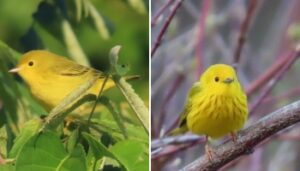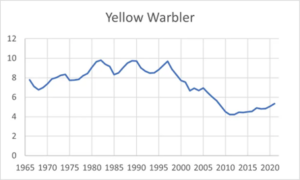(Photos and story by Pam Hunt)
August marks the beginning of southward migration for many species, and the aptly-named Yellow Warbler (Setophaga petechia) is among the first of our breeding warblers to depart in the fall. By late July local birds and their young will disperse from the shrubby wetlands where they breed and start to appear in areas where they weren’t seen all summer. Look for them in shrubby edges, sometimes accompanying yellowthroats or Chestnut-sided Warblers. They can remain common through August but become scarce by mid-September while other warblers are peaking.

This is one of the few warblers with breeding populations both in temperate North America and tropical areas, but whereas “our” breeding birds use shrubs and wetlands, those to our south (including the Florida Keys) are restricted to coastal mangroves. In fact, populations of this species in Central and South America, which have solid rusty heads, are colloquially known as “Mangrove Warblers” and may be a separate species. In the winter, the Yellow Warblers that breed in the United States and Canada sometimes share coastal habitats with their non-migratory cousins but are just as likely to be found in wetlands and shrublands similar to their breeding sites.
Yellow Warblers build their nests of fine bark, other plant fibers, and spider webs, giving them a silvery-gray color. While well-concealed during the breeding season, they are often easy to find in fall and winter when shrubs have lost their leaves. Brown-headed Cowbirds have no problem finding them under the leaves however, and the Yellow Warbler is a frequent host of that brood parasite. The warblers usually recognize the cowbird eggs as unusual and will build a whole new nest over them and lay a new clutch. Cowbirds can be equally stubborn however, and there are records of warbler nests with as many as six layers, each containing eggs of both species.

Populations of Yellow Warblers in much of the Northeast were stable through the late 1900s, only to decline sharply starting around the year 2000 (Figure 1). Reasons for this decline are unclear, and populations in the Midwest and West don’t show it as strongly if at all. The good news is that the decline appears to have stopped in the 2010s, and even shows some sign of recovery, but overall there are certainly fewer Yellow Warblers in the region than there were a few decades ago.
State of the Birds at a Glance:
- Habitat: Shrubby wetlands
- Migration: Medium-distance
- Population trend: Strongly declining
- Threats: Collisions, Cats, Habitat Loss
- Conservation actions: Protect wetlands
More information on “The State of New Hampshire’s Birds” is available here. Full species profiles in the format of “Bird of the Month” are now available here.
